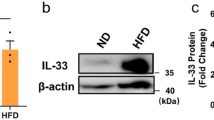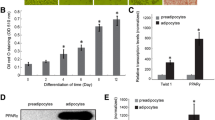Abstract
NYGGF4 is a novel gene that is abundantly expressed in the adipose tissue of obese subjects and is involved in insulin resistance. In the present study, the mRNA expression of NYGGF4 homologous genes was examined in the 3T3-L1 cell line. The NYGGF4 mRNAs were expressed at low levels in the 3T3-L1 preadipocytes. During the conversion of 3T3-L1 preadipocytes to adipocytes, the expression of NYGGF4 mRNA was upregulated. On the 8th day after induction of differentiation, the NYGGF4 mRNA levels peaked and remained high. Free fatty acids (FFA) and tumor necrosis factor-α (TNFα) could upregulate NYGGF4 mRNA expression in 3T3-L1 adipocytes, while interleukin-6 (IL-6), leptin, and resistin exerted an inhibitory effect. The results suggest that the expression of NYGGF4 mRNA is affected by a variety of factors that are related to insulin sensitivity. It is likely that NYGGF4 may be an important mediator in the development of obesity-related insulin resistance.



Similar content being viewed by others
References
Jeffery RW, Sherwood NE (2008) Is the obesity epidemic exaggerated? No. Br Med J 336:244–246. doi:10.1136/bmj.39458.495127.AD
Kopelman PG (2000) Obesity as a medical problem. Nature 404:635–643
Spiegelman BM, Flier JS (2001) Obesity and the regulation of energy balance. Cell 104:531–543. doi:10.1016/S0092-8674(01)00240-9
Qiu J, Ni YH, Gong HX, Fei L, Pan XQ, Guo M, Chen RH, Guo XR (2007) Identification of differentially expressed genes in omental adipose tissues of obese patients by suppression subtractive hybridization. Biochem Biophys Res Commun 352:469–478. doi:10.1016/j.bbrc.2006.11.049
Wang B, Zhang M, Ni YH, Liu F, Fan HQ, Fei L, Pan XQ, Guo M, Chen RH, Guo XR (2006) Identification and characterization of NYGGF4, a novel gene containing a phosphotyrosine-binding (PTB) domain that stimulates 3T3–L1 preadipocytes proliferation. Gene 379:132–140. doi:10.1016/j.gene.2006.05.008
Zhang CM, Chen XH, Wang B, Liu F, Chi X, Tong ML, Ni YH, Chen RH, Guo XR (2009) Over-expression of NYGGF4 inhibits glucose transport in 3T3–L1 adipocytes via attenuated phosphorylation of IRS-1 and Akt. Acta Pharmacol Sin 30:120–124. doi:10.1038/aps.2008.9
Caratù G, Allegra D, Bimonte M, Schiattarella GG, D’Ambrosio C, Scaloni A, Napolitano M, Russo T, Zambrano N (2007) Identification of the ligands of protein interaction domains through a functional approach. Mol Cell Proteomics 6:333–345. doi:10.1074/mcp.M600289-MCP200
Goossens GH (2008) The role of adipose tissue dysfunction in the pathogenesis of obesity-related insulin resistance. Physiol Behav 94:206–218. doi:10.1016/j.physbeh.2007.10.010
Boden G (1997) Role of fatty acids in the pathogenesis of insulin resistance and NIDDM. Diabetes 46:3–10. doi:10.2337/diabetes.46.1.3
Hotamisligil GS, Shargill NS, Spiegelman BM (1993) Adipose expression of tumor necrosis factor-alpha: direct role in obesity-linked insulin resistance. Science 259:87–91. doi:10.1126/science.7678183
Vozarova B, Weyer C, Hanson K, Tataranni PA, Bogardus C, Pratley RE (2001) Circulating interleukin-6 in relation to adiposity, insulin action, and insulin secretion. Obes Res 9:414–417. doi:10.1038/oby.2001.54
Maffei M, Halaas J, Ravussin E, Pratley RE, Lee GH, Zhang Y, Fei H, Kim S, Lallone R, Ranganathan S (1995) Leptin levels in human and rodent: measurement of plasma leptin and ob RNA in obese and weight-reduced subjects. Nat Med 1:1155–1161. doi:10.1038/nm1195-1155
Steppan CM, Bailey ST, Bhat S, Brown EJ, Banerjee RR, Wright CM, Patel HR, Ahima RS, Lazar MA (2001) The hormone resistin links obesity to diabetes. Nature 409:307–312. doi:10.1038/35053000
Student AK, Hsu RY, Lane MD (1980) Induction of fatty acid synthetase synthesis in differentiating 3T3–L1 preadipocytes. J Biol Chem 255:4745–4750
Bergman RN, Ader M (2000) Free fatty acids and pathogenesis of type 2 diabetes mellitus. Trends Endocrinol Metab 11:351–356. doi:10.1016/S1043-2760(00)00323-4
Dresner A, Laurent D, Marcucci M, Griffin ME, Dufour S, Cline GW, Slezak LA, Andersen DK, Hundal RS, Rothman DL, Petersen KF, Shulman GI (1999) Effects of free fatty acids on glucose transport and IRS-1-associated phosphatidylinositol 3-kinase activity. J Clin Invest 103:253–259. doi:10.1172/JCI5001
Gao Z, Zhang X, Zuberi A, Hwang D, Quon MJ, Lefevre M, Ye J (2004) Inhibition of insulin sensitivity by free fatty acids requires activation of multiple serine kinases in 3T3–L1 adipocytes. Mol Endocrinol 18:2024–2034. doi:10.1210/me.2003-0383
Moller DE (2000) Potential role of TNF-alpha in the pathogenesis of insulin resistance and type 2 diabetes. Trends Endocrinol Metab 11:212–217. doi:10.1016/S1043-2760(00)00272-1
Stephens JM, Lee J, Pilch PF (1997) Tumor necrosis factor-alpha-induced insulin resistance in 3T3–L1 adipocytes is accompanied by a loss of insulin receptor substrate-1 and GLUT4 expression without a loss of insulin receptor-mediated signal transduction. J Biol Chem 272:971–976. doi:10.1074/jbc.272.2.971
Ozes ON, Akca H, Mayo LD, Gustin JA, Maehama T, Dixon JE, Donner DB (2001) A phosphatidylinositol 3-kinase/Akt/mTOR pathway mediates and PTEN antagonizes tumor necrosis factor inhibition of insulin signaling through insulin receptor substrate-1. Proc Natl Acad Sci USA 98:4640–4645. doi:10.1073/pnas.051042298
Bastard JP, Maachi M, Van Nhieu JT, Jardel C, Bruckert E, Grimaldi A, Robert JJ, Capeau J, Hainque B (2002) Adipose tissue IL-6 content correlates with resistance to insulin activation of glucose uptake both in vivo and in vitro. J Clin Endocrinol Metab 87:2084–2089. doi:10.1210/jc.87.5.2084
Rotter V, Nagaev I, Smith U (2003) Interleukin-6 (IL-6) induces insulin resistance in 3T3–L1 adipocytes and is, like IL-8 and tumor necrosis factor-alpha, overexpressed in human fat cells from insulin-resistant subjects. J Biol Chem 278:45777–45784. doi:10.1074/jbc.M301977200
Stouthard JM, Oude Elferink RP, Sauerwein HP (1996) Interleukin-6 enhances glucose transport in 3T3–L1 adipocytes. Biochem Biophys Res Commun 220:241–245. doi:10.1006/bbrc.1996.0389
Steensberg A, Fischer CP, Sacchetti M, Keller C, Osada T, Schjerling P, van Hall G, Febbraio MA, Pedersen BK (2003) Acute interleukin-6 administration does not impair muscle glucose uptake or whole-body glucose disposal in healthy humans. J Physiol 548:631–638. doi:10.1113/jphysiol.2002.032938
Glund S, Deshmukh A, Long YC, Moller T, Koistinen HA, Caidahl K, Zierath JR, Krook A (2007) Interleukin-6 directly increases glucose metabolism in resting human skeletal muscle. Diabetes 56:1630–1637. doi:10.2337/db06-1733
Friedman JM, Halaas JL (1998) Leptin and the regulation of body weight in mammals. Nature 395:763–770. doi:10.1038/27376
Luoh SM, Di Marco F, Levin N, Armanini M, Xie MH, Nelson C, Bennett GL, Williams M, Spencer SA, Gurney A, de Sauvage FJ (1997) Cloning and characterization of a human leptin receptor using a biologically active leptin immunoadhesin. J Mol Endocrinol 18:77–85. doi:10.1677/jme.0.0180077
Steppan CM, Bailey ST, Bhat S, Brown EJ, Banerjee RR, Wright CM, Patel HR, Ahima RS, Lazar MA (2001) The hormone resistin links obesity to diabetes. Nature 409:307–312. doi:10.1038/35053000
Juan CC, Au LC, Fang VS, Kang SF, Ko YH, Kuo SF, Hsu YP, Kwok CF, Ho LT (2001) Suppressed gene expression of adipocyte resistin in an insulin-resist ant rat model probably by elevated free fatty acids. Biochem Biophys Res Commun 289:1328–1333. doi:10.1006/bbrc.2001.6132
Le Lay S, Boucher J, Rey A, Castan-Laurell I, Krief S, Ferre P, Valet P, Dugail I (2001) Decreased resistin expression in mice with different sensitivities to a high-fat diet. Biochem Biophys Res Commun 289:564–567. doi:10.1006/bbrc.2001.6015
Acknowledgments
This work was supported by grants from the National Natural Science Foundation of China (Grant Number: 30973231) and Program of Medical Leading Talent in Jiangsu Province (Grant Number: LJ200624)
Author information
Authors and Affiliations
Corresponding authors
Additional information
Ya-ping Zhao and Chun-mei Zhang contributed equally to this work.
Rights and permissions
About this article
Cite this article
Zhao, Yp., Zhang, Cm., Zhu, C. et al. NYGGF4 homologous gene expression in 3T3-L1 adipocytes: regulation by FFA and adipokines. Mol Biol Rep 37, 3291–3296 (2010). https://doi.org/10.1007/s11033-009-9914-7
Received:
Accepted:
Published:
Issue Date:
DOI: https://doi.org/10.1007/s11033-009-9914-7




